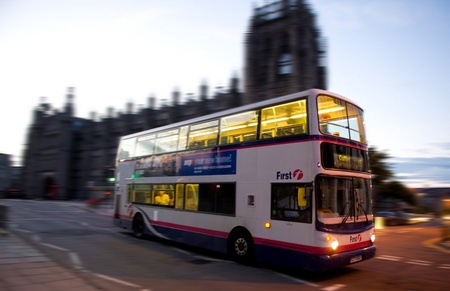A vision of what Aberdeen’s transport infrastructure could look like in the future will be discussed today (Thursday June 10).
A meeting hosted by the University of Aberdeen’s Centre for Transport Research, will bring together key representatives from Aberdeen city and shire’s transport sector.
A paper by leading transport experts from the University, which outlines suggestions for improvements which could be made to the city’s transport systems, will be amongst the topics up for discussion.
These suggestions include:
- A call to place transport investment and mobility management at the heart of regeneration strategies and discussions about Aberdeen’s future
- A revised public transport network to meet the current needs of Aberdeen’s citizens, businesses and visitors
- The consideration of making sections of Union Street, King Street and Market Street bus and taxi only
- The potential pedestrianisation of Union Street, but with access for buses
- Extension of bus priority times
- Multi-modal integrated ticketing – whereby passengers would buy one ticket which would enable them to board different modes of transport i.e. bus and train. This would simplify the transport system offered and recognise the needs of Aberdeenshire residents travelling in the city
The paper also outlines lessons Aberdeen could learn from transport systems and initiatives developed in other European countries.
These examples include:
- The Bus rapid Transit (BRT) system employed in Madridwhereby links between bus and metro lines were redesigned to make journey’s more efficient. This system has proven to ease congestion, improve air quality and reduce bus journey times by 40%
- In Gothenburg the city centre’s main street has priority for buses, trams and taxis, with full ticket integration between these three modes of transport meaning passengers need only purchase one ticket to travel on all. Air quality and congestion issues in the central area of the city have been eliminated
- Nanteshas tackled issues with congestion by introducing city centre pedestrianisation while maintaining access for public transport. Motorway access in the city has been reduced to one lane each way for cars with the remaining lanes bus only, providing 30% quicker access by bus compared to car
Professor John Nelson, Director of the University of Aberdeen Centre for Transport Research, said: “The meeting will bring key representatives from the local transport sector together and stimulate an informed debate about the crucial role of transport in the future development of Aberdeen and the surrounding area. We want to put transport at the heart of discussions on planning Aberdeen's future.
“The discussion paper developed by the Centre for Transport Research to highlight the transport issues facing Aberdeen and how other European cities have successfully tackled similar challenges will be one of the main points of discussion.
“The overall objective of this paper is to progress and communicate the process of change that will transform Aberdeen into one of the world’s leading cities of the future as well as promoting the excellent work already done by existing stakeholders locally.”
Representatives from Nestrans, Aberdeen City Council, Aberdeen City and Shire Economic Future (ACSEF), First Group, and Aberdeen Harbour Board will be amongst those attending today’s meeting which takes place in the Linklater Rooms on the University’s King’s College campus.


